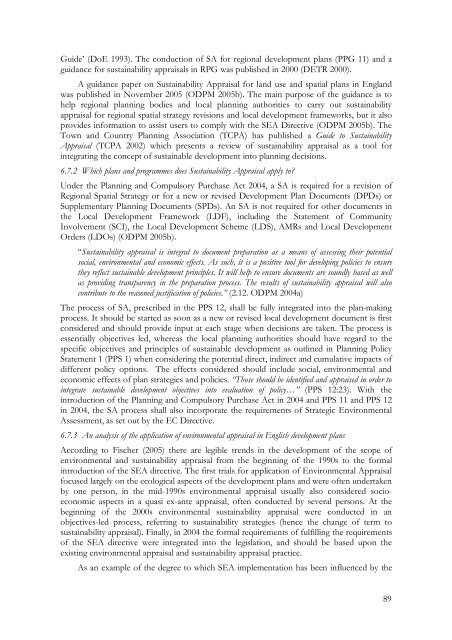SEA IN THE CONTEXT OF LANDTUSE PLANNING
SEA IN THE CONTEXT OF LANDTUSE PLANNING
SEA IN THE CONTEXT OF LANDTUSE PLANNING
Create successful ePaper yourself
Turn your PDF publications into a flip-book with our unique Google optimized e-Paper software.
Guide’ (DoE 1993). The conduction of SA for regional development plans (PPG 11) and aguidance for sustainability appraisals in RPG was published in 2000 (DETR 2000).A guidance paper on Sustainability Appraisal for land use and spatial plans in Englandwas published in November 2005 (ODPM 2005b). The main purpose of the guidance is tohelp regional planning bodies and local planning authorities to carry out sustainabilityappraisal for regional spatial strategy revisions and local development frameworks, but it alsoprovides information to assist users to comply with the <strong>SEA</strong> Directive (ODPM 2005b). TheTown and Country Planning Association (TCPA) has published a Guide to SustainabilityAppraisal (TCPA 2002) which presents a review of sustainability appraisal as a tool forintegrating the concept of sustainable development into planning decisions.6.7.2 Which plans and programmes does Sustainability Appraisal apply to?Under the Planning and Compulsory Purchase Act 2004, a SA is required for a revision ofRegional Spatial Strategy or for a new or revised Development Plan Documents (DPDs) orSupplementary Planning Documents (SPDs). An SA is not required for other documents inthe Local Development Framework (LDF), including the Statement of CommunityInvolvement (SCI), the Local Development Scheme (LDS), AMRs and Local DevelopmentOrders (LDOs) (ODPM 2005b).“Sustainability appraisal is integral to document preparation as a means of assessing their potentialsocial, environmental and economic effects. As such, it is a positive tool for developing policies to ensurethey reflect sustainable development principles. It will help to ensure documents are soundly based as wellas providing transparency in the preparation process. The results of sustainability appraisal will alsocontribute to the reasoned justification of policies.” (2.12. ODPM 2004a)The process of SA, prescribed in the PPS 12, shall be fully integrated into the plan-makingprocess. It should be started as soon as a new or revised local development document is firstconsidered and should provide input at each stage when decisions are taken. The process isessentially objectives led, whereas the local planning authorities should have regard to thespecific objectives and principles of sustainable development as outlined in Planning PolicyStatement 1 (PPS 1) when considering the potential direct, indirect and cumulative impacts ofdifferent policy options. The effects considered should include social, environmental andeconomic effects of plan strategies and policies. “Those should be identified and appraised in order tointegrate sustainable development objectives into evaluation of policy…” (PPS 12:23). With theintroduction of the Planning and Compulsory Purchase Act in 2004 and PPS 11 and PPS 12in 2004, the SA process shall also incorporate the requirements of Strategic EnvironmentalAssessment, as set out by the EC Directive.6.7.3 An analysis of the application of environmental appraisal in English development plansAccording to Fischer (2005) there are legible trends in the development of the scope ofenvironmental and sustainability appraisal from the beginning of the 1990s to the formalintroduction of the <strong>SEA</strong> directive. The first trials for application of Environmental Appraisalfocused largely on the ecological aspects of the development plans and were often undertakenby one person, in the mid-1990s environmental appraisal usually also considered socioeconomicaspects in a quasi ex-ante appraisal, often conducted by several persons. At thebeginning of the 2000s environmental sustainability appraisal were conducted in anobjectives-led process, referring to sustainability strategies (hence the change of term tosustainability appraisal). Finally, in 2004 the formal requirements of fulfilling the requirementsof the <strong>SEA</strong> directive were integrated into the legislation, and should be based upon theexisting environmental appraisal and sustainability appraisal practice.As an example of the degree to which <strong>SEA</strong> implementation has been influenced by the89
















